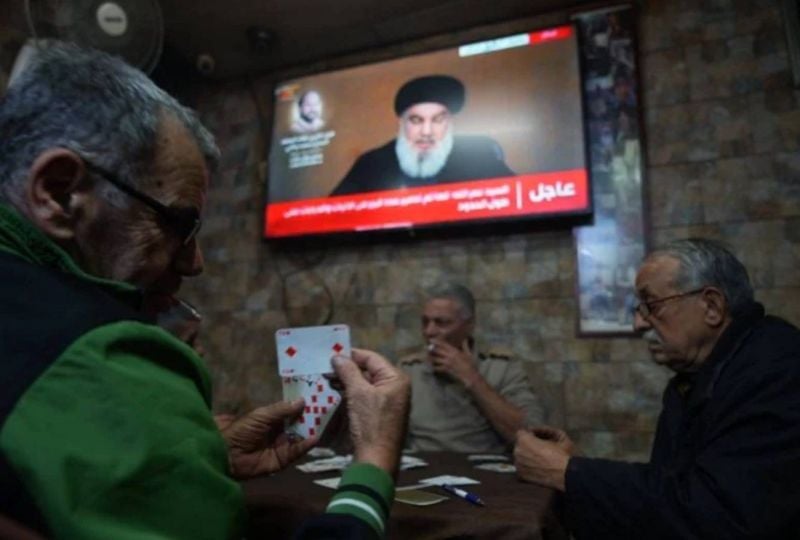
On a Friday night at the Bourj al-Brajneh refugee camp in Beirut's southern suburbs, men follow Hezbollah leader Hassan Nasrallah's speech, while playing cards. Jan. 5, 2024. (Credit: Mohammad Yassine/L’Orient-Le Jour)
Hezbollah has a complex identity that has evolved over the decades as the party expanded. Created by Iran’s Islamic Revolutionary Guard Corps (IRGC) in the early 1980s, Hezbollah functions as a resistance movement, militia party, social organization, international mafia, and regional intervention force.
Depending on the situation, the organization takes on one or more of these roles, without completely letting go of the others. This versatility is Hezbollah’s main strength and renders it challenging to comprehend, let alone combat.
As Hezbollah matured, it deepened its roots in Lebanon, assumed a leading role in the country, and naturally prioritized certain aspects of its identity over others.
Rather than persistently pursuing the dream of “liberating Palestine,” the party’s “divine victory” in 2006 prompted a shift in its focus.
Over the next decade, Hezbollah directed the majority of its efforts toward solidifying its position on the Lebanese landscape, evolving into a powerful and dominant entity.
Instead of weakening its position, Hezbollah’s interventions in Syria, Iraq and Yemen throughout the 2010s instilled a sense, sometimes substantiated, that it could assume a regional role. During this period, it increasingly embraced the role of the primary executor of Iranian policy in the Middle East.
In just 15 years, Hezbollah has emerged as a dominant, albeit controversial force in Lebanon, and a significant player on the regional stage.
However, the organization’s newfound status subdued its inclination to engage in conflict with Israel, its original adversary. The Lebanese-Israeli border has remained peaceful for 17 years, and Hezbollah even approved the signing of an agreement on the delineation of the maritime border with Israel in 2022.
The party clarified at the time that this agreement did not constitute a form of normalization and was solely focused on technical issues. Despite this explanation, it was apparent to observers that Hezbollah was not signaling a relinquishment of “resistance” but rather indicating a shift in its priorities, which were primarily focused on stabilizing gains in Lebanon and the Arab world.
Not the same as in 2006
The recent Hams attack on Oct. 7 was unexpected and changed the dynamics significantly.
It remains unclear whether Hezbollah was oblivious to Hamas’ plan for a large-scale attack or if it was genuinely surprised, as it claims. Three months later, the question still holds much mystery.
What is certain, however, is that since the start of hostilities with Israel on Oct. 8, Hezbollah has consistently taken measures within its strategic framework to prevent an all-out war.
Israel has crossed all red lines, striking deep into Lebanese territory, causing civilian casualties, assassinating Hamas’ second-in-command in Beirut’s southern suburb, and killing 158 Hezbollah fighters. Yet, the party has maintained its commitment to fighting per established rules of engagement.
The deployment of American aircraft carriers in the region, intended to deter Hezbollah, has indeed achieved its desired effect. The pro-Iranian group is aware that the balance of power would strongly work against it, and engaging in open warfare with Israel could potentially lead to its weakening or even elimination.
Taking such a risk is not feasible for Hezbollah unless the stakes are existential for itself or its sponsor, Iran.
Hezbollah’s priority is to maintain dominance in Lebanon and Iran’s influence in the region, not to “liberate Palestine.”
Hezbollah is not the same as it was in 2006 because it now has much more to lose than it did then.
As the primary shareholder in the Lebanese state, the organization is obligated to act accordingly.
Hezbollah is willing to militarily support Bashar al-Assad’s regime, take extreme measures to obstruct justice in cases like the assassination of Rafik Hariri and the Aug. 4 Beirut port explosion, and brag about its alleged “100,000 fighters” after the 2021 Tayouneh clashes, but it does not want to embark on a new military venture against Israel.
Hezbollah’s recent conduct underscores its evolution. The past three months have not caused the party to reassess the path it has been on since 2006 —if anything, they have accelerated the party’s transformation. So much so that party leader Hassan Nasrallah now expresses openness to post-war talks with the Israeli enemy.
Hezbollah’s unprecedented move of agreeing to negotiate Israel’s withdrawal from the occupied territories, a central aspect of the rhetoric justifying its weapons, implies a shift. This also suggests an acknowledgment of Israel’s existence, an intention to discontinue fighting its enemy from the southern front, and a realization that it no longer requires this excuse to justify its unique status on the Lebanese scene.
Hezbollah doesn’t seek immediate peace and will persist with its rhetoric of “resistance.” However, it is evidently willing to prolong this conflict indefinitely, akin to late Syrian President Hafez al-Assad’s approach to conflict in the Golan Heights in the mid-1970s.
To draw a parallel, the 1974 disengagement agreement negotiated by Kissinger, allowed the former Syrian president to disentangle himself from a war he couldn’t win without making peace. This strategy enabled Assad Sr. to focus on strengthening his position first in Syria and then in Lebanon.
Similarly, Hezbollah seems poised to freeze the current conflict, maintaining its resistance narrative while concentrating on consolidating its influence in Lebanon and the broader region.
Since 2006, Hezbollah has taken on a more Lebanese identity. Not in the sense that its actions prioritize Lebanon’s interests over Iran’s, but in the sense that Lebanon’s destiny is now intricately connected to its own.
On a positive note, this increased connection implies that Hezbollah is more obligated to consider Lebanese realities in its decision-making.
On the flip side, it also signifies a concerted effort to shape Lebanon’s reality to align even more with its objectives. Hezbollah now perceives itself as the de facto state and aspires for complete domination of the Lebanese landscape.
This article was originally published in French in L'Orient-Le Jour. Translation by Sahar Ghoussoub.